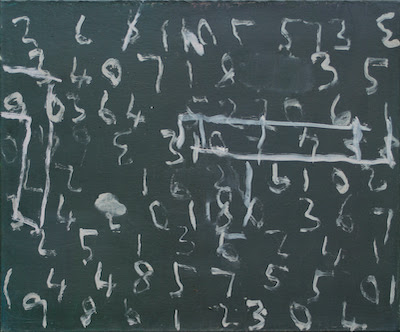Halftime by Andrew Crane is a striking example of Abstract Expressionism, a movement that emphasizes spontaneity, emotional intensity, and a dynamic interplay of color and form. Created in 2019, this piece captures the artist’s signature style—marked by gestural strokes, layered textures, and an evocative use of acrylic on canvas. With its raw energy and contemplative depth, Halftime invites viewers to immerse themselves in a world of abstract narratives, where interpretation is deeply personal.
Medium and Techniques
Executed in acrylic on canvas, Halftime showcases Crane’s expertise in manipulating pigments to create depth and movement. Acrylic paint, known for its quick-drying properties, allows for both controlled layering and spontaneous gestures. In this piece, Crane employs a mix of bold brushstrokes, subtle drips, and textural contrasts, producing a composition that feels both deliberate and organic. The artist’s use of layering results in a multi-dimensional surface, where certain elements appear to recede while others emerge, engaging the viewer in a continuous visual exploration.
Crane’s process likely involves a combination of thick impasto applications and delicate washes, creating a sense of contrast between heavy and light, dense and transparent. The visible brushwork contributes to the expressive quality of the painting, revealing the artist’s hand in every stroke. This direct engagement with the canvas fosters a connection between the creator and the observer, allowing the artwork to resonate on a visceral level.
The Aesthetic and Visual Composition
At first glance, Halftime appears to be a convergence of energy and introspection. The composition presents an interplay of forms, colors, and textures that evoke a range of emotions. The lack of a clear focal point encourages viewers to engage with the entire canvas, letting their eyes wander across the surface to uncover its nuances.
Color Palette and Mood
Crane’s color choices in Halftime are crucial in shaping the mood of the piece. Abstract Expressionist painters often use color as a primary vehicle for emotion, and in this work, the interplay between bold and muted tones creates a striking balance between tension and harmony. There is an undeniable sense of movement, with colors blending and contrasting in a way that suggests both urgency and reflection.
The tonal relationships in Halftime contribute to its overall atmosphere—some areas might exude a warmth and intensity, while others convey coolness and serenity. This dynamic interplay allows viewers to engage with the painting in multiple ways, depending on their own emotional state and perspective.
Texture and Surface Quality
Texture plays a vital role in this piece, adding to its tactile and visual richness. The thick, gestural applications of paint create a sculptural effect, while thinner washes provide moments of subtlety. The juxtaposition of these textures enhances the sense of depth and invites viewers to imagine the artist’s process—each mark, each layer contributing to the final composition.
Movement and Energy
One of the defining features of Halftime is its kinetic energy. The gestural strokes and fluid transitions suggest a sense of motion, as if the painting is in a constant state of evolution. This aligns with the philosophy of Action Painting, a technique championed by Abstract Expressionists like Jackson Pollock and Franz Kline, where the act of painting itself becomes an integral part of the artwork. In Halftime, Crane embraces this spontaneity, allowing instinct and intuition to guide his hand.
Interpretation and Meaning
Abstract Expressionism thrives on open-ended interpretation, and Halftime is no exception. The title itself—Halftime—hints at a pause, a midpoint, or a moment of transition. This could suggest a narrative of reflection, change, or anticipation. The viewer is encouraged to engage with the painting on an emotional level, drawing from their own experiences to extract meaning.
Could Halftime represent a moment of rest amid chaos? Perhaps it embodies a turning point in a journey, whether personal or collective. The ambiguity of abstract art allows for multiple readings, making Halftime a deeply personal experience for each viewer.
Psychological and Emotional Resonance
Abstract art often speaks to the subconscious, bypassing rational analysis to tap into pure emotion. Halftime possesses a meditative quality, inviting introspection. The interplay of bold strokes and delicate transitions may evoke a sense of inner conflict, resolution, or even serenity. The emotional depth of the piece ensures that no two viewers will perceive it in exactly the same way.
The Artist: Andrew Crane
Andrew Crane is known for his distinctive approach to abstraction, often blending gestural expression with nuanced textures and layered compositions. His works are celebrated for their raw authenticity and emotional depth, making them highly sought after by collectors and art enthusiasts alike. Crane’s ability to balance spontaneity with control—allowing chance and intention to coexist—places him within the lineage of modern Abstract Expressionist painters.
His artistic philosophy emphasizes freedom, intuition, and emotional honesty, qualities that are evident in Halftime. Through his work, Crane encourages viewers to embrace ambiguity and find their own narratives within abstraction.
Context in the Abstract Expressionist Movement
Abstract Expressionism emerged in the mid-20th century as a response to the social and political upheavals of the time. Artists sought to break free from traditional artistic constraints, emphasizing individual expression, spontaneity, and the power of gesture. Figures like Mark Rothko, Willem de Kooning, and Jackson Pollock paved the way for a movement that prioritized emotion over representation.
Crane’s work, including Halftime, continues this legacy while introducing contemporary sensibilities. His approach to abstraction reflects a deep understanding of the movement’s principles, yet he brings a fresh, personal touch that makes his work uniquely his own.
Collecting and Displaying Halftime
Owning a piece like Halftime is an opportunity to engage with a living artistic dialogue. Abstract Expressionist works often serve as conversation starters, evoking different reactions based on light, mood, and personal interpretation.
When displaying Halftime, consider placing it in a minimalist setting, where its textures and colors can take center stage. The absence of a frame allows the painting to maintain its raw, unfiltered energy. Whether in a gallery, home, or office, this piece has the power to transform a space, imbuing it with both dynamism and introspection.
Impression
Halftime by Andrew Crane is more than just a painting—it is an experience, a journey, and an invitation to introspection. Its layered textures, expressive brushwork, and evocative composition make it a standout example of contemporary Abstract Expressionism.
Whether one sees it as a moment of transition, a burst of energy, or a meditative pause, Halftime resonates with the timeless power of abstraction. It is a testament to the freedom of artistic expression and a reminder that meaning is not fixed but ever-evolving—just like the artwork itself.
No comments yet.








